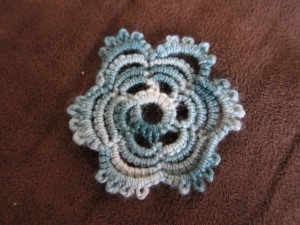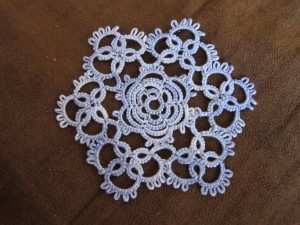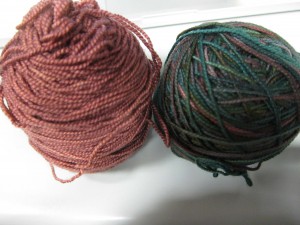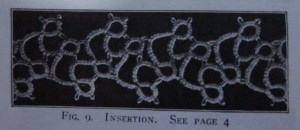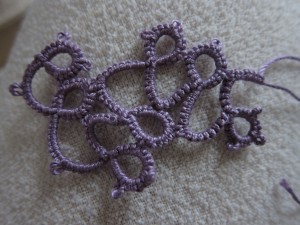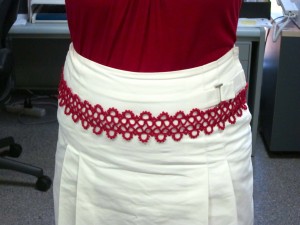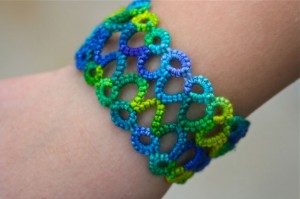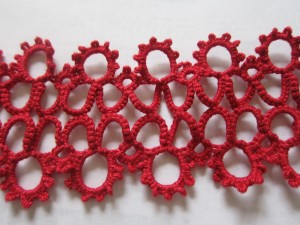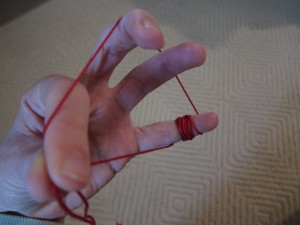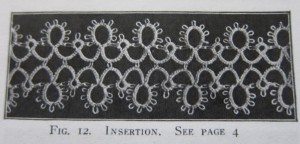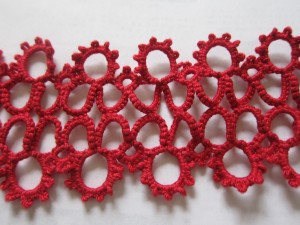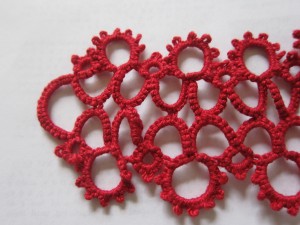I’ve actually got this belt finish, (mostly, I’ll clarify at the bottom of this post) but don’t have good pictures and have it packed at the moment. I took the train back from San Diego to Seattle this week and haven’t gotten myself organized again yet. I did take pictures earlier on in the project so I’m going to post those and go through the pattern. I’ll post the finished pictures when I get unpacked, but here’s  what it looked like when I had finished one strip of it.
what it looked like when I had finished one strip of it.
The whole thing was just under 18 inches. When I made my first belt I made the tatting portion of it 27 inches long so that it would be the largest part of the belt, but I ended up liking the way the ribbon looked (especially once I added a little bit of tatting to it to cover up how I attached it to the main part of the belt) and decided that for the next one I’d make the main tatting portion of it smaller. So sadly, the difference in the the sizes of the two is an astethics thing and not that I lost 9 inches around my waist. :( If I want to lose 9 inches off my waist I probably shouldn’t spend my time sitting on the couch tatting. (Actually, I do tat while hiking, but I haven’t done that lately.)
Anyway, here’s the original pattern:
 Nice and simple, right? Well, if you have the picture in front of you. It’s actually a little trickier than written because the joins aren’t intuitive. I love how they just say “joining as in the cut”. Though, admittedly, it’d be a pain in the butt to explain write it all out and it probably wouldn’t make sense. You really do need to have the picture in front of you for the first couple repeats. Here’s “the cut”:
Nice and simple, right? Well, if you have the picture in front of you. It’s actually a little trickier than written because the joins aren’t intuitive. I love how they just say “joining as in the cut”. Though, admittedly, it’d be a pain in the butt to explain write it all out and it probably wouldn’t make sense. You really do need to have the picture in front of you for the first couple repeats. Here’s “the cut”:

Instead of the 6-6 chains I did 5-5. Just seemed to work better for me, but that’s probably a function of how I tat. I think my chains tend to be looser than my rings so if you’re going to try the pattern, see what works for you. Other than that I didn’t change anything, but I did add a shoelace trick after the first ring for every repeat after the first to keep the chains from twisting. (If you’re doing it all in one color you could just use two shuttles and switch which is the ring shuttle and which is the chain shuttle with each repeat) There’s also some annoying stuff going on with the joins if you pay attention to frontside/backside tatting. I don’t normally, and didn’t worry about it on this as far as doing my rings vs. chains, but in this pattern you’re joining chains to rings so you do need to pay attention to it for the joins. I’ll explain that after the pattern.
Here’s my modernized shorthand version of the instructions. I’ll label the rings R1 and R2 and the chains Ch1 and Ch2 so that hopefully my explanation of where to do the joins will make more sense.
(R1) 5-5-5-5 (NEVER joined to anything when first tatted. (This was hard for me to remember. Lots of retro-tatting because of this.))
*(Ch1) 5-5 (after the first round, this is always joined at the picot to the last picot of R2 from the previous repeat.)
(R2) 5+(always joined to the last picot of the first ring) 5-5-5
(Ch2) 8-8 (always joined at the picot to the middle (2nd) picot of R2 from the PREVIOUS repeat.)
(R1) 5-5-5-5. (Note that this ring is NOT joined to anything.)
Shoelace trick to switch the threads before the next chain.
Repeat from * joining as described.
Does all that make sense? Let me know if this is clear. (Part of the whole point of doing this blog is for practice in writing up patterns, so please, always feel free to let me know what’s helpful and what’s confusing). Would it make more sense if the the “guidelines” for joining were written after the pattern when you’re working on the second repeat?
Finally, a note about the joins. If you’re using two colors you have to pay attention to your joins because you’re doing joins of chains to rings. When you do a join with threads of different colors you get a little blip of color with your joins. Usually I don’t worry about that and just call the side where that happens the “back” side. Problem is that with this pattern you do a shoelace trick to reverse the work with each repeat. This means that the blips of color are not all on the same side of the tatting anymore. They switch sides with each repeat. Arg.
If you want to avoid the color you’ve got to switch your type of join with each repeat. I usually do an up join, but for every other repeat I needed to do a down join for the chains to rings joins. Pain. In. The. Butt. Very hard to remember and I did it wrong a few times so I’ve still got the blips of color on both sides. I might not have worried much except that since I was using size 3 thread on this the colors are petty noticeable. (To me anyway). At Camp Wannatat, Sandy showed me the Larks Head join which is more work, but gets rid of the blip. This would have been a good project to practice this on, but unfortunately, I totally forgot about it until after I finished the tatting. Another time, perhaps.
When I started messing around with this pattern I picked it because I wanted a relatively thick edging that could be done in one pass. I wasn’t sure if I would like the final version because I didn’t know if it worked in just one color. Seemed too chaotic. I think it’s much better in two colors and I like it this way, but decided I’d do the doubled over version anyway to make a really wide belt. I’m just a sucker for symmetry, and even though the final version doesn’t have left-right symmetry, it does have top-bottom symmetry and that makes me feel better…
So I tatted up a second row and added it to the first as I went. The whole 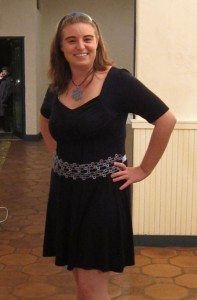 frontside/backside tatting with regards to the joins was an even bigger pain in the butt to keep track of for the second row, so there’s a bunch of mistakes there too. I decided at the last minute to wear it to a wedding. (Picture on the right. Don’t you love the matching necklace! That’s the center part of the motif from the star doily in Priscilla Book #3 in the same size 3 blue thread as the rings on the belt. The color is a little funky in the picture, but the dress is actually a dark blue, not black.) I ended up sewing on the ribbons at my friend’s hotel room when I went to pick her up to head over to the church. This means that I haven’t yet gotten around to tatting up something to cover the sewing. I do have an idea for that though, so maybe sometime this week. When I’m done with the “finishing” work I’ll take more pictures of the whole thing.
frontside/backside tatting with regards to the joins was an even bigger pain in the butt to keep track of for the second row, so there’s a bunch of mistakes there too. I decided at the last minute to wear it to a wedding. (Picture on the right. Don’t you love the matching necklace! That’s the center part of the motif from the star doily in Priscilla Book #3 in the same size 3 blue thread as the rings on the belt. The color is a little funky in the picture, but the dress is actually a dark blue, not black.) I ended up sewing on the ribbons at my friend’s hotel room when I went to pick her up to head over to the church. This means that I haven’t yet gotten around to tatting up something to cover the sewing. I do have an idea for that though, so maybe sometime this week. When I’m done with the “finishing” work I’ll take more pictures of the whole thing.
I’ve really enjoyed making belts. They work up pretty quickly in size 3 thread and it’ll be fun to have a bunch of them to easily add some lace to dresses. Plus, they’ll be a great way to try out a lot of the edgings in the Priscilla books. Since I think I’m going to make more I’ve even gone and given them their own category to the right. This way all the belts will be easily browse-able.
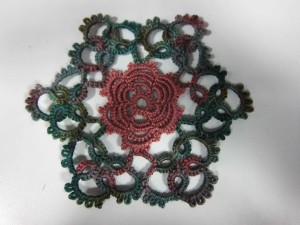 Here’s the finished motif in yarn for the belt. I really like these colors and love the way it came out. Overall it wasn’t too hard to tat with the yarn. I definitely had to watch as I made my stitches to make sure I tatted a bit more loose than usual, especially on the rings, but that wasn’t much of a problem.
Here’s the finished motif in yarn for the belt. I really like these colors and love the way it came out. Overall it wasn’t too hard to tat with the yarn. I definitely had to watch as I made my stitches to make sure I tatted a bit more loose than usual, especially on the rings, but that wasn’t much of a problem.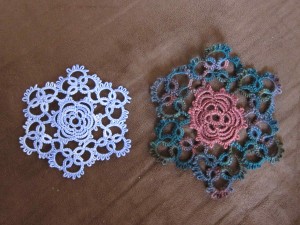 doing the rest of the belt in that center color would look good.
doing the rest of the belt in that center color would look good.
